Looking Back: #10264 Corner Garage
Let’s revisit one of the less popular recent sets in the series to see how it compares to the four sets that came out after it…
Several years ago, Jeannie reviewed #10264 Corner Garage here at Brick Architect. It’s a great review which explores the build process and overall impressions in great detail.
In building and reviewing the last four modulars myself, I’ve grown to appreciate the theme more than I had expected, which is why I have decided to go back in time (as time and expense allows) to revisit some of the earlier sets in the beloved series.
Rather than write a redundant in-depth review, I’ve decided to focus on my main impressions of the (now retired) set — five years after it was originally released. Corner Garage was not especially popular when it was initially released — one of my motivations in revisiting this set was to understand if the less-than-sterling reputation is deserving.
Please note that this review is based on a used (but meticulously disassembled) copy instead of a boxed set. (At the time of this article, you can find a used copy of #10264 Corner Garage on ebay for about 250$ and a new copy for around $325.)
Build Process
The first bag is actually a bit different than recent sets for a few reasons. For one, we do not have an intricate tile floor pattern because the first floor interior is an automotive garage and the exterior is just concrete. More generally, we aren’t building a sumptuously decorated interior, but rather a gritty commercial space. This means swapping out leather couches and fancy lobbies for a wheel-truing stand, automotive lift, and oil can out back. I also really noticed the older style of instructions — This set has just 6 numbered bags, versus 15 in #10312 Jazz Club. On reflection, this is actually kind of nice, since each bag represents a decent chunk of time and a nice chance to take a break.
The second bag continues where we left off, adding the rest of the interior walls, a large module set at a 45 degree angle with the front door and windows, and the garage door mechanism. I am very much noticing the decision to leave the interior floor unfinished, but I am conflicted about whether this is a cost-saving measure, or an attempt to make the interior of a workshop look less ‘finished’ than the fancy tile floor of a hotel lobby. I’m willing to consider as I suspect it was intended – a rougher interior look for a workspace that is designed to be functional over fancy.
We’re still working on the first floor in the third of six bags, suggesting that the second and third floors may be simpler than many other modulars. With the main structure complete, the focus shifts to the gas pump out front, and a large rounded awning that covers up the area where a car would drive through to fill up their tank. Lastly, we actually get to build a vehicle in this set. It’s a small but nice looking tow truck which features a hook that can be raised and lowered by rotating a gear on top. The two-tone blue color scheme looks nice next to the dark green and white building.
The fourth bag builds the entire second floor, which is a pretty straightforward assembly apart from the angled front facade and the angled interior wall between the lobby and veterinary office. The highlight for me was the various decorations inside of vet office, especially the terrarium for the frog and the microscope near the door. By contrast, the blue couch and chair in the lobby are quite crude compared to more recent sets.
As with the previous bag, the fifth bag completes the third floor studio apartment. Apart from the continued lack of walls or railings for the staircase, and no door between the apartment and the stairwell, the large apartment occupies the entire floor and looks pretty comfortable, thanks to a large kitchen, bathroom, bed and TV. The exterior detailing is almost identical to the floor beneath it, which continues to look good thanks to the striking Dark Orange color.
The sixth and final bag completes the roof. It has a moderately decorative cornice which bridges the dark orange color from the lower floors to a light-gray trim. A lawn chair and umbrella allows a single minifigure to relax on the rooftop. It’s a nice touch, but I wish we had one more storytelling detail, such as a barbecue grill.
Conclusion
I have tried to provide an objective assessment of the merits of this set rather than accept the pessimistic narrative established when the set was initially released. I also want to acknowledge that this model represents a different cross-section of our communities with the inclusion of a mechanic/garage.
I want to ensure that I’m not bringing a white-collar bias to a set which features a working-class job and a matching aesthetic. This is especially relevant when we look at the first floor interior, which does not have a tile floor unlike every Modular since the Parisian Restauraunt. I am inclined to give the designers benefit of the doubt here, and assume that this was a deliberate choice to represent a ‘working’ space with a rougher interior than the lobby of a fancy hotel. I also suspect that they felt like they could save on parts here and better use the parts budget for other details like the Tow Truck.
Another first floor detail that really bothers me is the staircase. It makes no sense that there isn’t a wall between the staircase and the interior of the mechanic’s shop (there isn’t even a railing). Speaking of the lack of walls, it’s not all that believable that a Veterinarian’s office would rent out the space above a garage – wouldn’t the constant noise make it impossible to keep pets (or their owners) calm when performing procedures? Maybe that’s why the fish in the tank is upside-down.
Continuing to the second and third floors, the furnishings aren’t as nice as in more recent modulars, but they do convey a sense of space well. We are blessed with one interior door between the second story lobby and the small Veterinarian’s office. As noted earlier, the office is well decorated. Apart from the continued lack of walls around doors or walls around the staircase, the third floor apartment looks pretty comfortable compared to some other sets in the series, with a generous kitchen and enough space to move around.
On the plus side, the exterior detailing is pretty realistic. I imagine that the brick building was constructed in the late 1800’s, and underwent a first-floor renovation in the late 1930’s to add the Gas Station and Garage. Those features are in the Streamline Moderne style, a late Art Deco style that focuses on rounded forms which were typically constructed using economical materials like Concrete — it was the Depression after all…
I imagine that the brick building was constructed in the late 1800’s, and underwent a first-floor renovation in the late 1930’s to add the Gas Station and Garage.
To be clear, I enjoyed the build process and think the completed model looks pretty good. I also appreciate the car lift function, the garage door (although it gets stuck if you twist it too hard), and the generally comfortable 3rd floor apartment. That said, I am ultimately left wanting for a bit more… simple gray tiles on the floor of the shop, walls around the staircase, and better looking couches.
Ranking the five most recent modulars:
- #10278 Police Station (2021) – Must Have (5/5 stars).$200, 2923 pieces.
- #10297 Boutique Hotel (2022) – Recommended (4/5 Stars).
$230, 3066 pieces. - #10312 Jazz Club (2023) – Recommended (4/5 Stars).
$230, 2899 pieces. - #10270 Bookshop (2020) – Recommended (4/5 Stars).
$200, 2504 pieces. - #10264 Corner Garage (2019) – Good (3/5 Stars).
$200, 2569 pieces.
To add a bit more context to my rankings, I believe that the Police Station and Boutique Hotel are nearly equal in quality. The Boutique Hotel has a more innovative composition and build techniques, but the Police Station takes top marks due to better storytelling, play features, and slightly better value. As noted in my recent review of the Jazz Club, it’s a good set overall, but falls below the previous two because it lacks both the storytelling punch of the Police Station and the compositional excellence of the Boutique Hotel.
Near the bottom, we have the Bookshop. While they manage to pack a lot into each of the two half-width buildings, you can’t achieve the efficiency or compositional flexibility of models that squeeze two overlapping buildings into one baseplate. This leaves the Corner Garage at the bottom of the stack, largely due to the significantly low level of detailing on the interior.
All said, I completely agree with Jeannie’s earlier “Good” (3/5 Star) rating for this set. It is genuinely good and I’m thrilled to have more diverse workplaces represented in our city.

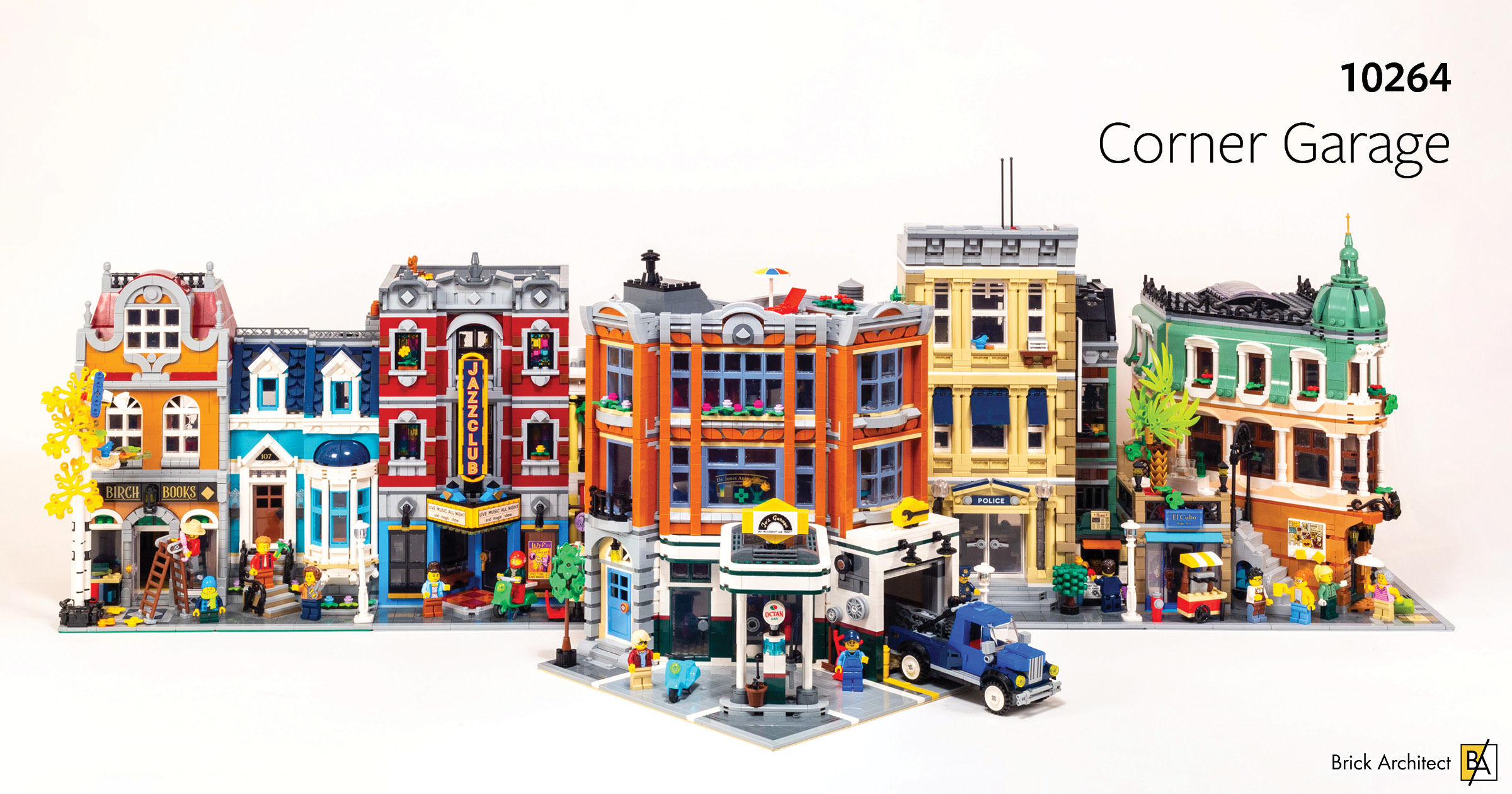

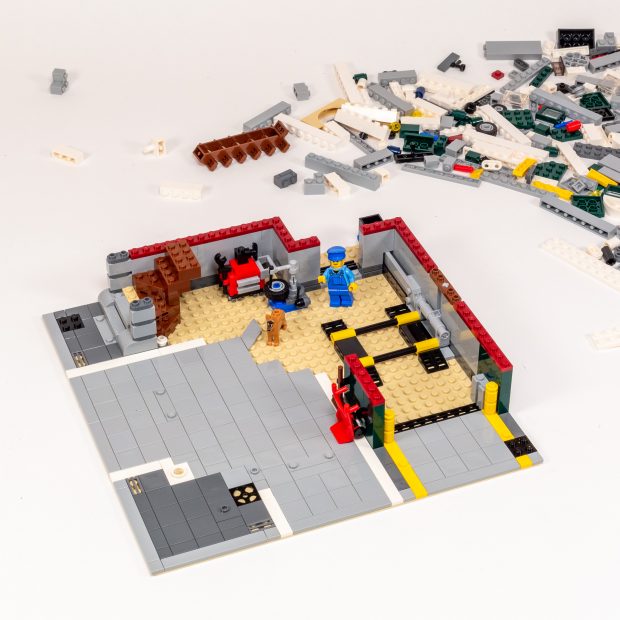
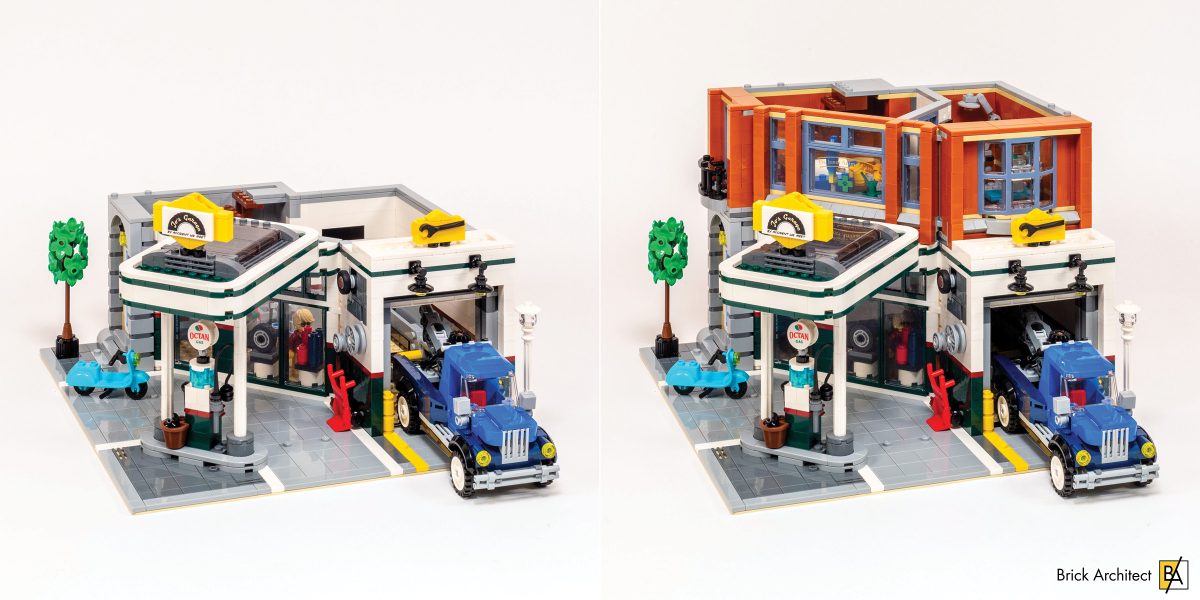
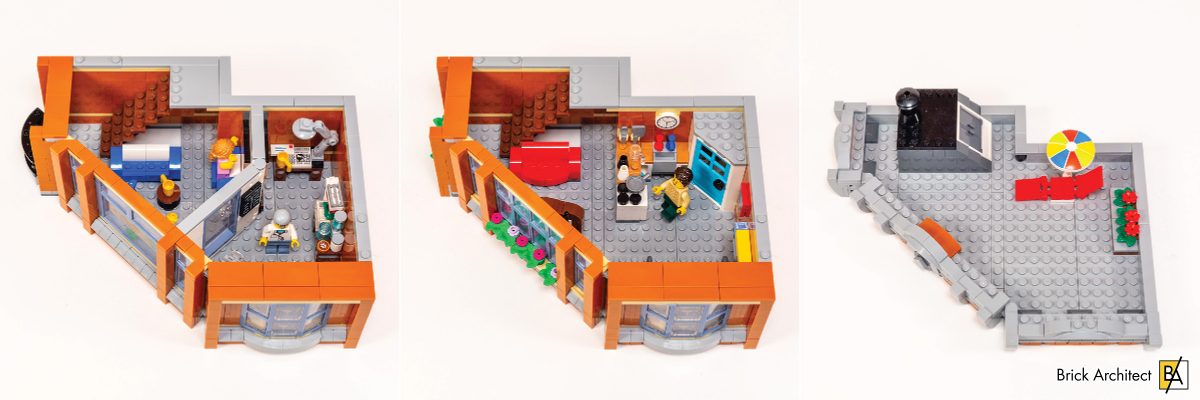
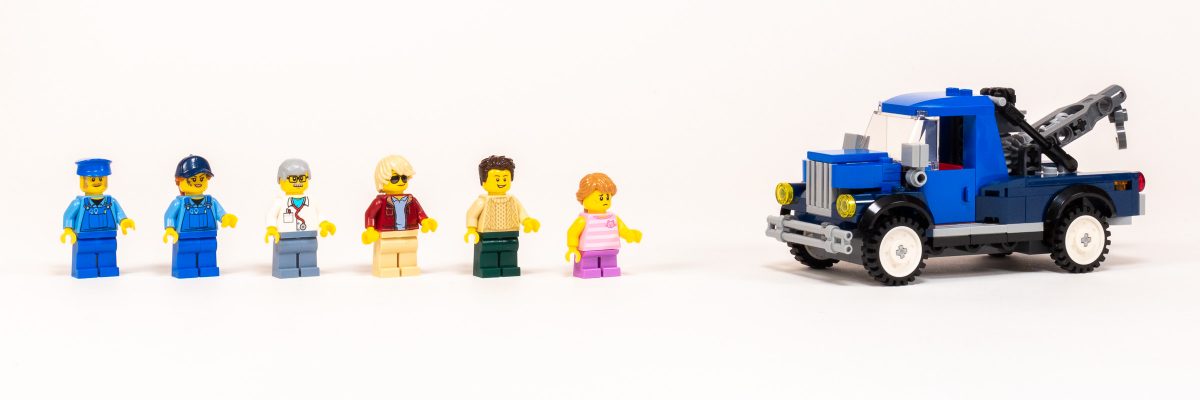
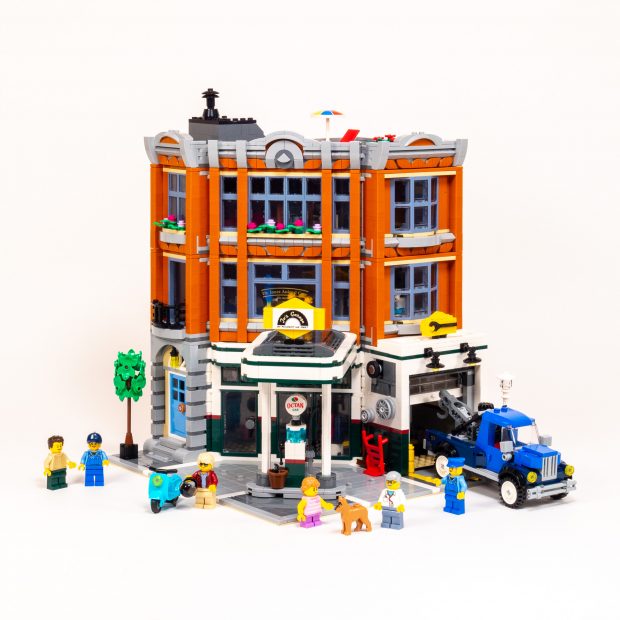
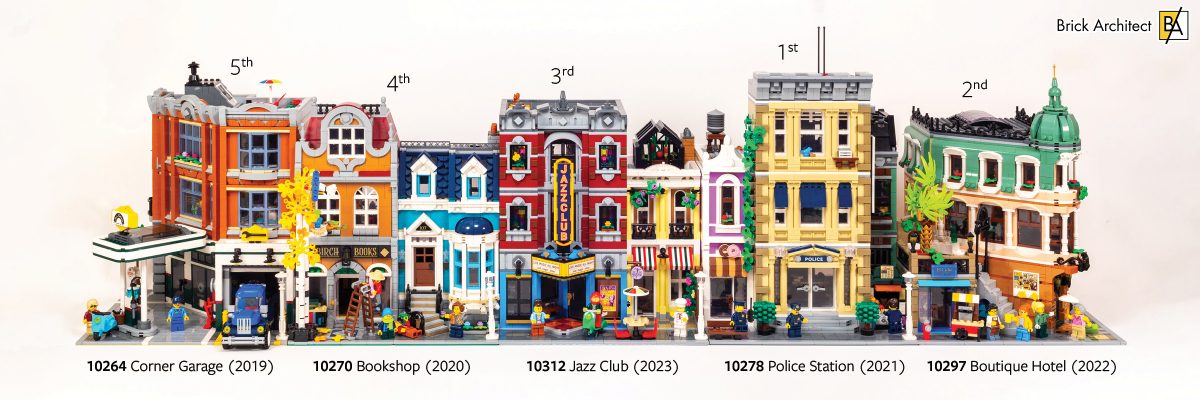

The 10264 Corner Garage set is a masterpiece of LEGO architecture! It’s impressive how much detail and creativity go into these sets. LEGO enthusiasts like me always appreciate a trip down memory lane.
I think that the set is good overall,but there are some problems like the lack of detail in the garage,the exterior walls look kinda plain and the bed in the apartment looks uncomfortable.Still,the apartment is my favourite floor in the building,because I think it was done really well(besides the bed).
I wanted the set since I was little and now I’m hoping to get it second hand because it is a nice corner building
I think that the set is good overall,but there are some problems like the lack of detail in the garage,the exterior walls look kinda plain and the bed in the apartment looks uncomfortable.Still,the apartment is my favourite floor in the building,because I think it was done really Well(besides the bed).
The veterinarian’s office and apartment above the garage don’t make sense in context, and they look very plain, cold, and uncomfortable. If I had the Corner Garage, I would treat the upper levels as warehouse space for the garage (auto parts) and for other establishments in the Modular city. The building just looks like a warehouse to me. I can’t imagine living in it or doing a white-collar job that requires a quiet, clean environment.